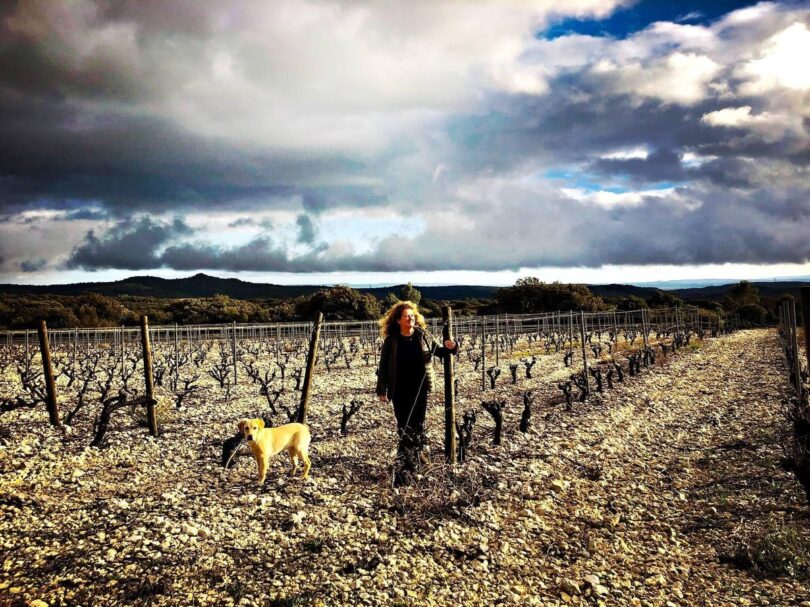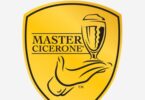Nicole Bojanowski in Minervois vineyard during winter
Raised in the U.S. state of Kentucky and college educated in the state of Rhode Island, John Bojanowski spent one senior year college term studying in Poland. This was just before the fall of the wall separating eastern and western Europe in the late 1980’s.
Mesmerized by the experience, he returned to the U.S., completed his thesis in critical literary theory, and decided he wanted more.
‘I said—I’m going back to Poland. But teaching English paid $100 a month in Poland at the time, so that wasn’t an option for paying off my loans. I decided to find a company that wanted someone to travel to Eastern Europe. Meanwhile, the wall came down, and so having been in Poland appeared maybe to be useful.’
Bojanowski found a job working for a manufacturer of power supplies for computers. He was based in Paris, and for almost five years traveled extensively to Eastern Europe. During this time he met his wife to be Nicole, who grew up in Saint-Marcel-sur-Aude in the Languedoc region of southern France, close to the city of Narbonne. She was working as an export manager for wine cooperatives.
Clos du Gravillas vines surrounded by forests
‘She wanted to make her own wine—a grand vin rouge. To do that she was very specific—she was going to plant Syrah and Cabernet Sauvignon grapes at altitude on white limestone gravel.’
Nicole took John to visit the small village of Saint-Jean-de-Minervois in southern France. The beauty of vines and landscape drew him in. The couple have now lived in this village for over a quarter century, raised a son, tended 8.5 hectares (21 acres) of grapevines and now fashion vintages from 18 different grape types. They sell their wines throughout France and the U.S. under their Clos du Gravillas label.
At first, winemaking was a challenge.
Nicole obtained an agricultural diploma and then picked grapes during a harvest in Burgundy. John, meanwhile, learned to drive a tractor and also toiled at a harvest in southern France. As we walked through fermentation and barrels rooms, adjacent to their dwelling, he recalled the experience.
‘We bought this place in 1996. We were basically looking for a house that needed to be renovated, and this also had outer buildings. This room was a stable, and everything else was in ruins. We poured concrete, put in electricity, and that was our winery. We had two fermentation tanks. Red grapes that came in were destemmed and then crushed in these red 90 liter buckets. Then the buckets were lifted up to the mezzanine floor with a mason’s winch, and after that I ran upstairs and dragged them over and poured them into tanks. Labor intensive. A lot of effort, but it worked. It’s also a very gentle way of getting grapes into tanks.’
Vines and stone cabin at dusk in Saint Jean de Minervois
During their first harvest, the couple reduced the quantity of grapes by thinning their crop to modify the period for fruit ripening and to alter color and sugar levels. The practice shocked some locals vine growers.
‘First year, when we were dropping grapes they were like—what’s your problem? That’s money, and you’re throwing it away? Okay, you’re crazy!’
In time their number of fermentation tanks grew. They replaced the winch with more modern and less labor intensive equipment. Although John loved their screw press, he finally agreed to replace it with a pneumatic press after it broke down mid-harvest one year.
The area of their vineyards also grew.
‘We try things. When they work, they tend to stick around. Probably that’s a difference from other growers. In college my Rhode Island license plates read: ‘What If’—and that encapsulates our approach.
‘In the beginning there was a half hectare [1.25 acres] of very old Carignan vines, and the other half was Grenache Gris. The old Carignan had the quality of being black grapes, so we were at least going to be able to make some red wine while we planted Syrah and Cabernet Sauvignon and waited up to five years for those grapes to mature.
‘The only other Grenache Gris we could find in the south was from Banyuls-sur-Mer. So we went down there and visited and asked questions—how do you work with this grape type? Since then—whereas most people know us because of the old Carignan—this Grenache Gris is what’s opened doors in Michelin star restaurants.
John and Nicole Bojanowski of Clos du Gravillas, Minervois, France
‘Two times we’ve made pure Cabernet Sauvignon. 2015 and 2017. We thought it would be a shame not to see what the potential of the grape here is.’
I tasted their 2017 Pic de Saint-Jean Cabernet Sauvignon, from the highest vines in Saint-Jean-de-Minervois. Aromas include dark chocolate, red plums and licorice, and the wine will pair well with meat fondue. There is an attractive dark matrix of flavors in the mouth, with a light waft on the finish. My affection for this beauty grew with every sip.
‘When we arrived here my wife had absolutely no plans to make Muscat, but people came knocking on the door on Sunday mornings asking did we have Muscat. A piece of land that came with the house across the street was plantable for Muscat, so in 2001 we had 83 ares of Muscat and started making that [an ‘are’ is a unit of land 100 square meters in area, or roughly 1,100 square feet]. It turned out to be a very good idea. It’s much more interesting to make fortified wines than we would have expected. And we’ve done a late harvest two times.’
Other wines they make include L’Inattendu (’the unexpected’), a blend of Grenache Gris, Grenache Blanc and Maccabeu. I tasted the 2021 vintage—honey, grapefruit, pear, lime and apricot aromas and a rich oily mouth feel with intense white fruit flavors.
Sous les cailloux des Grillons wine – a blend of five grapes
Their bottle labels include the silhouette shape of a crescent moon. I asked why.
‘You notice there are a lot of rocks around,’ John explained. ‘When there are no leaves here, it looks like the moon.’
Some notions not generally accepted still endure in the region. A few neighboring producers still believe that most wines should be high in alcohol—15% or more; others believe that younger winemakers should not sell their wines at a price more expensive than their elders, because they ‘haven’t suffered.’
John and Nicole have shared toil and joy associated with vines and making wines. Their website reads: ‘In 1996, this sud French girl convinced her southern bred boy that the white rocks of St Jean were the most beautiful rocks in the world. Now he sings, she dances.’
The future? They are now performing their 25th harvest with their son Sacha. They have also found someone to assist them in their vineyards, and are considering the prospect of selling.
They could do so with pride. Their legacy includes helping to elevate the overall quality, status and reputation of the southern French wines of Minervois.








